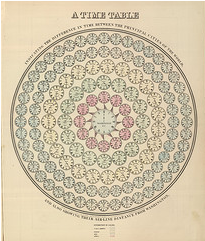Carnival of Mathematics #74 – The Tungsten Edition
Welcome to the slightly delayed Carnival of Mathematics #74 – Tungsten Edition. In a departure from COM tradition, this edition is on the same blog as the last edition due to a lack of hosting volunteers. Fortunately, however, the volunteers are starting to turn up and so this is the last month that you’ll have to put up with me for a while. Next month will see the carnival hosted by Daniel over at General Musings and April will be taken care of by AcmeScience (thanks peeps!). The rest of the year is up for grabs so if you’d like to host a future carnival then contact me and we’ll work something out.
One tradition that I’m not about to give up on, however, is the number trivia section. So, let’s see what 74 has for us. In stark contrast to 73, the Chuck Norris of Numbers, 74 doesn’t seem to have much going for it. It’s probably overweight for a start since it is the 3rd hungry number (hungry because it tries to eat as much Pi as possible). Other than that it is odious, semiprime and altogether rather dull!
Enough of the trivia and on with the show.
First up we have a post from Datavisualization.ch which shows a set of infographics from around 150 years ago. Much of this work is rather beautiful and demonstrates that the field of infographics is much older than you might think.
 For a rather more modern take on statistics and infographics I highly recommend the UK BBC Four TV documentary, The Joy of Stats. This was a one off show broadcast in late 2010 and hosted by Hans Rosling (Also the star of a brilliant TED talk). Several clips of the show are available over at The Open University and it was recently mentioned by The Royal Statistical Society.
For a rather more modern take on statistics and infographics I highly recommend the UK BBC Four TV documentary, The Joy of Stats. This was a one off show broadcast in late 2010 and hosted by Hans Rosling (Also the star of a brilliant TED talk). Several clips of the show are available over at The Open University and it was recently mentioned by The Royal Statistical Society.
From statistics and onto the theory of numbers with a post by Matt Springer called ‘Sunday Function’. In this post, Matt demonstrates a wonderfully simple proof concerning fractions which have terminating decimal expansions. It turns out that it just happened to be a Sunday morning when I read this delightful little post over coffee and it set me up for the day.
Number theory has been big news in the mathematical world recently thanks to some work by Ken Ono and colleagues who have found a finite, algebraic formula for partition numbers. The original papers can be found at http://www.aimath.org/news/partition/ (thanks to everyone on twitter who sent me that) and there has been discussion all over the web including at Wired.com and The Language of Bad Physics. Emory University (where Ken works) have a press-release but the best resource I’ve found so far is an informal talk by the man himself at YouTube (see below).
One of my biggest personal interests is mathematical software and so my contribution to this month’s carnival is a round-up of mathematical software news for January. January also saw a post from Wolfram Research on how to use some of Mathematica’s new control theory functions to stabilize an inverted pendulum which also serves as a nice introduction to some standard control theory techniques.
Another mathematical software article that was brought to my attention last month was a post from the Mathcad team concerning a very simple looking integral. Computers often do symbolic calculus using different techniques to human beings and this is occasionally reflected in the results. Check out the article for the details.
On a lighter note, we have Music is Math: Ten Songs about Mathematics from Dave Richeson of ‘Division by Zero’ fame. My favourite of the bunch is ‘A finite simple Group of Order 2’ (below) which I’ve some across before. The rest of them, however, are new to me and a lot of fun (and in a couple of cases, quite nice to listen to).
My boss used to be a research mathematician and is something of a pedant (In a good way Chris…in a good way). It seems that this is a trait he has in common with Peter Rowlett, author of Travels in a mathematical world, who has written a piece called Pedantry on Euler and Masts where he investigates the facts behind an old Euler story. There’s also some interesting discussion of the difficulty of presenting maths for the masses.
Whereas I do Random Walking, Sander Huisman does Random Hopping and in the process he comes up with some great looking pictures and interesting mathematics.
John D. Cook compares the iPhone to the method of least squares in When it works, it works really well, Ed4All shows us a mental arithmetic short cut for squares ending in five and Math-Frolic presents A Seemingly Impossible Task, That Isn’t.
Last but by no means least, Guillermo Bautista, organiser of the Math and Multimedia blog carnival, gives us an introduction to similarity while Alasdair’s Musings brings us A cute result relating to sums of cubes.
- Follow the Carnival of Math on Twitter: @Carnivalofmath
- Learn more about Math Carnivals: What is a math carnival?


Nice collection. Thanks for promoting my carnival. You are most welcome to host.